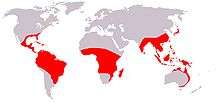Burmanniaceae
| Burmanniaceae Temporal range: Late Cretaceous - Recent 85–0 Ma | |
|---|---|
 | |
| Scientific classification | |
| Kingdom: | Plantae |
| (unranked): | Angiosperms |
| (unranked): | Monocots |
| Order: | Dioscoreales |
| Family: | Burmanniaceae Blume[1] |
| Genera | |
|
see text | |
 | |
| Range of Burmanniaceae | |
| Synonyms | |
| |
Burmanniaceae is a family of flowering plants, consisting of about a hundred species of herbaceous plants in roughly a dozen genera.
Description
Often they are quite remarkable plants, more often red than green, without much leaf area and not growing very big in any way. The reason for this appearance is that the members of the family are all myco-heterotrophic species. They are mainly distributed in the southern hemisphere and grow in shady and tropical environments. Many of the plants in the family are threatened species.
Taxonomy
John Lindley described the family as Burmanniae, with the single genus Burmannia, in 1830.[2] The APG II system, of 2003, places the family in the order Dioscoreales, in the clade monocots. The circumscription of the family in APG II is wider than in the APG system, of 1998, and includes the plants that belonged to the family Thismiaceae in APG.
However, the older classification better reflects the evolutionary relationships[3] between the genera. The clades are as follows:
Burmanniaceae sensu stricto
- Apteria
- Burmannia
- Campylosiphon
- Cymbocarpa
- Dictyostega
- Gymnosiphon
- Hexapterella
- Marthella
- Mierisella
Afrothismia clade
Tribe Thismieae
According to molecular analyses, the myco-heterotrophic type of life that these species lead evolved six (or even more) times independently in the three clades that are part of Burmanniaceae. Afrothismia and tribe Thismieae represent two of these shifts to myco-heterotrophy from autotrophy while Burmanniaceae sensu stricto are the clade where the other four took place. The family appears in the Late Cretaceous but the further diversification and shifts to the typical habit occurred later in the same period and continued after the K-T boundary in Paleogene.
References
- ↑ Angiosperm Phylogeny Group (2009), "An update of the Angiosperm Phylogeny Group classification for the orders and families of flowering plants: APG III", Botanical Journal of the Linnean Society 161 (2): 105–121, doi:10.1111/j.1095-8339.2009.00996.x, retrieved 2010-12-10
- ↑ Lindley 1830, Burmanniae p. 257.
- ↑ http://bio.kuleuven.be/sys/site/Publicaties/2010/Vincent%20Merckx/Monocots%202010%20Merckx.pdf
Bibliography
- Merckx, V.; Schols, P.; Kamer, H. M.-v. d.; Maas, P.; Huysmans, S.; Smets, E. (1 November 2006). "Phylogeny and evolution of Burmanniaceae (Dioscoreales) based on nuclear and mitochondrial data". American Journal of Botany 93 (11): 1684–1698. doi:10.3732/ajb.93.11.1684.
- Lindley, John (1830). An introduction to the natural system of botany : or, A systematic view of the organisation, natural affinities, and geographical distribution, of the whole vegetable kingdom : together with the uses of the most important species in medicine, the arts, and rural or domestic economy. London: Longman. Retrieved 2 February 2014.
External links
- Burmanniaceae, Thismiaceae in L. Watson and M.J. Dallwitz (1992 onwards). The families of flowering plants: descriptions, illustrations, identification, information retrieval. Version: 9 March 2006. http://delta-intkey.com
- Monocot families (USDA)
- Burmanniaceae in the Flora of North America
- Burmanniaceae.org, a site dedicated to the research on this family
- the specialists at work
- NCBI Taxonomy Browser
- links and more links at CSDL, Texas
| Wikimedia Commons has media related to Burmanniaceae. |
| Wikispecies has information related to: Burmanniaceae |
|